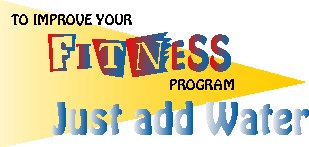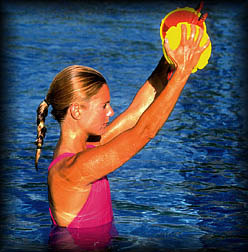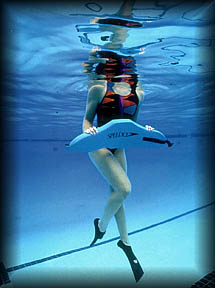

It is estimated that by the year 2005 individuals aged 65 and older in the United States will rise to 13 percent of the total population, Japan's elderly population will rise to 17 percent and West Germany's to 19 percent. Additionally the Sporting Goods Manufacturer's Association (SGMA) performed a nationwide survey on trends in fitness participation between 1987-1995. They found that strength training with free weights had become the most popular fitness activity during this time frame. An aging population, combined with the escalating interest in resistance training, emphasizes the need to begin increasing water fitness programming. Many participants see water fitness solely as an aerobic activity, but current research shows that it is a great form of resistance exercise that can provide life enhancing functional gains. During a recent study at the University of Nevada Reno sixty six sedentary women, who's average age was 75 years, were able to significantly improve their functional land activities, such as stair climbing, speed walking time, sit to stand and balance, after 16 weeks of participation in the GOLDEN WAVES, FUNCTIONAL WATER FITNESS PROGRAM (Sanders Constantino et al 1997) These women's lives changed dramatically as their daily tasks became easier to perform and new activities were added to their lives!

The American College of Sports Medicine (ACSM) revised it's position statement in 1990 to recommend two days per week of resistance training per week. Targeting the muscles that stabilize and support your body, can make your workouts more effective and improving your daily land activities.
Research supports the concept that moving through water provides "dynamic" muscular conditioning for the "trunk corset" muscles (abdominal, erector spine, obliques and upper back) which functions as a stabilizers. While land resistance, i.e. weight training, is considered the norm for muscle development. Studies now indicate that land resistance work may not provide the same optimal opportunity as water. To overload muscles in functional upright positions or through complete functional ranges of motion. (Kennedy Sanders 1995). In fact, an eight week water fitness training study performed in 1993 at the University of Nevada, indicated significant abdominal endurance improvement, in participants following vertical water exercise training that promoted postural alignment (Sanders, Rioppee, 1993).
The main argument supporting water resistance exercise is that water currents act constantly against the body, requiring the truck muscles to respond on a continual basis. In contrast, land resistance machines stabilize YOU, which may minimize the work required of the stabilizing/trunk muscles and consequently limit the benefits achieved through resistance training.

When you're in the pool it's time to think amphibious! Add exercises that functionally train your muscles and improve your healthy living on land. Swimmers and water exercisers simply need to apply the Specificity of Training principle to their resistance workouts. Specificity of Training implies that swim workouts train our bodies to work toward being better swimmer, strengthening and lengthening the muscles that optimize performance to move through the water.
As swimmers already recognize the performance benefits of training with "liquid weight" feeling of water, the Specificity of Training principle can be applied to water resistance exercise and it's benefits to daily living. For example, poor postural habits, practiced regularly on land, train our bodies, over over a period of time to yield to gravity, potentially resulting in rounded backs (stretched middle and lower trapezious, & rhomboids) and sloped shoulders (tight pectorals & stretched posterior deltoids). The corresponding weakening of the trunk can reduce your performance in sports and daily living. By using water resistance for specific strengthening, you can train from the "inside out", improving trunk corset muscles that contribute to better posture and allow you to stand taller, ski with more balance, skate longer and walk further, faster!
Physical Therapist, Deborah Ellison, explains it best when she states that targeted training will "ensure that we are optimally prepared for the challenges of daily life". So, don't forget to train muscles "wetside" for the "sport" of daily living "dryside"!
Mary E. Sanders, M.S. is Education Director for Speedo Internation Ltd./Wave Areobics and an adjunct faculty member at the University of Nevada, Reno conducting research in water fitness. She is a member of the exam writing committe for ACE (American Council on Excercise), Chair of the IDEA Water Fitness Advisory Committe and a YMCA instructor.
Carol A. Kennedy, M.S. is the Program Director of Fitness/Wellness at Indiana University with the Division of Recreational Sports at Indiana University and Post Chair of the IDEA Water Fitness Committee.
Special thanks to Kelly Roark for Editorial assistance.